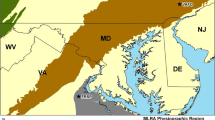Abstract
The area of wetlands in the U.S. is being estimated as part of the National Wetlands Inventory (NWI). Minimal information is available to verify the effectiveness of NWI maps to inventory wetlands or delineate jurisdictional wetlands. We evaluated the use of NWI maps (1∶24,000 scale) to inventory and delineate jurisdictional wetlands in the Virginia Blue Ridge. Each wetland identified in the Woolwine and Meadows of Dan NWI maps was field-checked to determine if the areas met the criteria as a jurisdictional wetland. Of the 171 palustrine wetlands identified, 91% met the criteria. Jurisdictional wetlands were delineated in four 2.5-minute study areas. Two study areas, located in the Blue Ridge Highlands region, contain 91.8 and 109.3 hectares of jurisdictional wetlands. The NWI maps indicated 2.5 and 17.4 hectares of wetlands in these two study areas. A similar but smaller discrepancy occurred in the areas mapped in the Blue Ridge Escarpment region. We concluded, because of the small scale that photo interpreters must work with and the number of wetlands located in dense woodlands, that NWI maps may not adequately inventory wetlands in the Blue Ridge. This conclusion was based on a detailed study of 22% (6888 ha) of the area covered on the NWI maps. Predominant plant species in the forested, scrub-shrub, and emergent wetlands were red maple (Acer rubrum), speckled alder (Alnus rugosa), and yellow nutsedge (Cyperus esculentus), respectively, Wetland soils were classified as Typic Humaquents and Humaqueptic Fluvaquents.
Similar content being viewed by others
Literature Cited
Bastian, R.K. and J. Benforado. 1988. Water quality functions of wetlands: Natural and managed systems. p. 87–97.In D.D. Hook, W.H. McKee, H.K. Smith, J. Gregory, V.G. Burrell, M.R. DeVoe, R.E. Sojka, S. Gilbert, R. Banks, L.H. Stolzy, C. Brooks, T.D. Matthews, and T.H. Shear (eds.) The Ecology and Management of Wetlands. Vol. 1: Ecology of Wetlands. Timber Press, Portland, OR, USA.
Brooks, R.P. 1989. An overview of ecological functions and economic values of wetlands. p. 11–20.In S.K. Majumdar, R.P. Brooks, F.J. Brenner, and R.W. Tiner, Jr. (eds.) Wetlands Ecology and Conservation. Emphasis in Pennsylvania. Typehouse of Easton, Phillipsburg, NJ, USA.
Butera, M.K. 1983. Remote sensing wetlands. IEEE Transactions on Geoscience and Remote Sensing 21:383–392.
Cowardin, L.M., V. Carter, F.C. Golet, and E.T. LaRoe. 1979. Classification of wetlands and deepwater habitats of the United States. U.S. Fish and Wildlife Service, Washington, DC, USA, FWS/OBS-79/31.
Dahl, T.E. 1993. Use of hydric soils in national programs of the U.S. Fish and Wildlife Service. p. 348.In Agronomy Abstracts, American Society of Agronomy. Madison, WI, USA.
Edmonds, W.J., D.D. Rector, and J.S. Quesenberry. 1992. Wet soils of Virginia. p. 93–99.In J.M. Kimble (ed.) Proceedings of the 8th International soil correlation meeting (VIII ISCOM): Characterization, classification, and utilization of wet soils. USDA. Soil Conservation Service, National Soil Survey Center, Lincoln, NE, USA.
Environmental Laboratory. 1987. Corps of Engineers wetland delineation manual. U.S. Army Engineer Waterways Experiment Station. Vicksburg, MS, USA. Technical Report Y-87-1.
Estrin, S.A. 1986. The delineation and classification of inland wetlands utilizing fcir stereo imagery. p. 713–716.In M.C.J. Damen, G.S. Smit, and H.T. Verstappen (eds.) Remote Sensing for Resources Development and Environmental Management, Enschede, the Netherlands, A.A. Balkema, Rotterdam, The Netherlands.
Federal Interagency Committee for Wetland Deliniation. 1989. Federal manual for identifying and deliniating jurisdictional wetlands. U.S. Army Corps of Engineers, U.S. Environmental Protection Agency, U.S. Fish and Wildlife Service, and USDA-SCS, Washington, DC, USA.
Guthrie, R.L. and J.E. Witty. 1982. New designations for soil horizons and layers and the new soil survey manual. Soil Science Society of America Journal 46:443–444.
Ingram, H.A.P. 1983. Hydrology. p. 67–158.In A.J.P. Gore (ed.) Ecosystems of the World, Mires: Swamp, Bog, Fen, and Moor. Elsevier, Amsterdam, The Netherlands.
Jensen, J.R., E.J. Christensen, and R. Sharitz. 1984. Nontidal wetland mapping in South Carolina using airborne multispectral scanner data. Remote Sensing of the Environment 16:1–12.
Kadlec, R.H., R.B. Williams, and R.D. Scheffe. 1988. Wetland evapotranspiration in temperate and arid climates. p. 146–160.In D.D. Hook, W.H. McKee, H.K. Smith, J. Gregory, V.G. Burrell, M.R. DeVoe, R.E. Sojka, S. Gilbert, R. Banks, L.H. Stolzy, C. Brooks, T.D. Matthews, and T.H. Shear (eds.) The Ecology and Management of Wetlands. Vol. 1: Ecology of Wetlands. Timber Press, Portland, OR. USA.
Mitsch, W.J. and J.G. Gosselink. 1993. Wetlands. Van Nostrand Reinhold, New York, NY, USA.
Moorhead, K.K. 1990. Diversity of hydric soils in North Carolina, USA. Environmental Management 14:241–247.
Reed, P.B., Jr. 1988a. National list of plant species that occur in wetlands: 1988 Virginia. U.S. Fish and Wildlife Service, Washington DC, USA. Biological Report 88 (18.46).
Reed, P.B., Jr. 1988b. National list of plant species that occur in wetlands: Southeast (Region 2). U.S. Fish and Wildlife Service, Washington, DC, USA. Biological Report 88 (26.2).
Rehder, J. and D. Quattrochi. 1978. The verification of Landsat data in the geographical analysis of wetlands in Tennessee. NASA Contractor Report No. 3012. Knoxville, TN, USA.
Soil Survey Staff. 1951. Soil survey manual. USDA-SCS Agricultural Handbook No. 18. U.S. Government Printing Office, Washington, DC, USA.
Soil Survey Staff. 1992. Keys to Soil Taxonomy, 5th edition. Blacksburg, VA, USA. Soil Management Support Services Technical Monograph No. 19.
Swartwout, D.J. 1982. An evaluation of the National Wetlands Inventory in Massachusetts. M.S. Thesis. University of Massachusetts, Amherst, MA, USA.
Tiner, R.W. 1984. Wetlands of the United States. Current status and recent trends. National Wetlands Inventory. U.S. Department of Interior, U.S. Fish and Wildlife Service, Washington, DC, USA.
Tiner, R.W. 1988. Field guide to nontidal wetland identification. Maryland Department of Natural Resources, Annapolis, MD, USA. and U.S. Fish and Wildlife Service, Newton Corner, MA, USA.
Tiner, R.W. 1991. The concept of a hydrophyte for wetland identification. Bioscience 41:236–247.
USDA-SCS, 1991. Hydric soils of the United States. USDA-SCS, Washington, DC, USA. Misc. Publication No. 1491.
Author information
Authors and Affiliations
Rights and permissions
About this article
Cite this article
Stolt, M.H., Baker, J.C. Evaluation of national wetland inventory maps to inventory wetlands in the southern Blue Ridge of Virginia. Wetlands 15, 346–353 (1995). https://doi.org/10.1007/BF03160889
Received:
Revised:
Accepted:
Issue Date:
DOI: https://doi.org/10.1007/BF03160889




